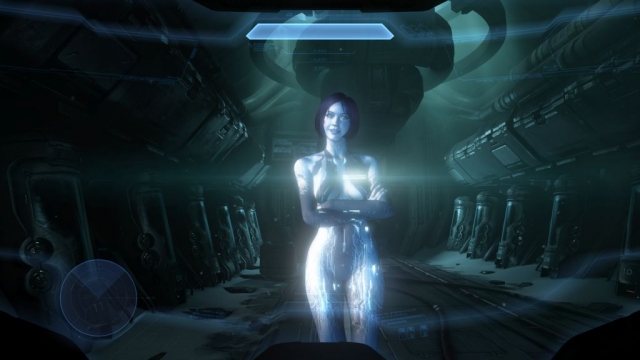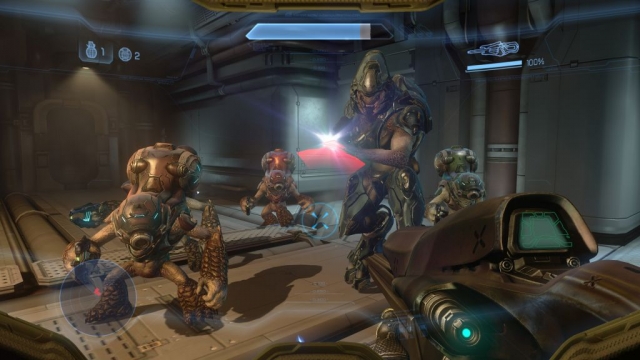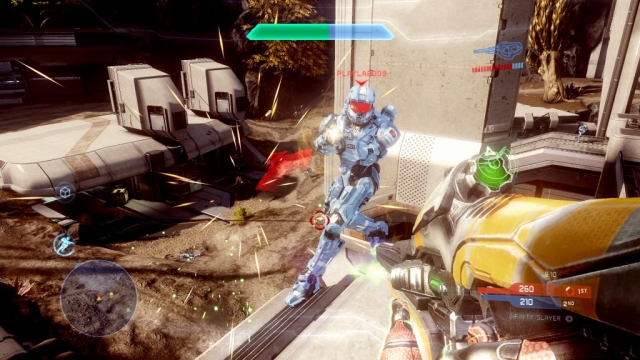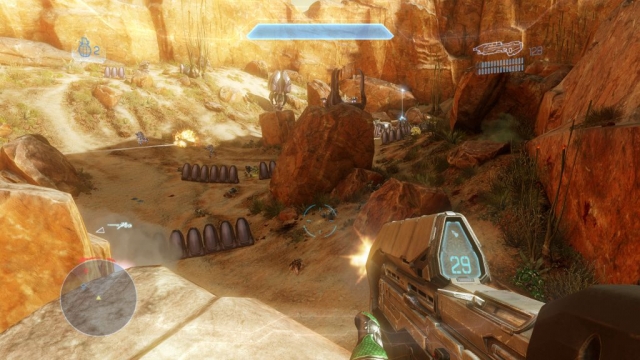Halo 4 Review
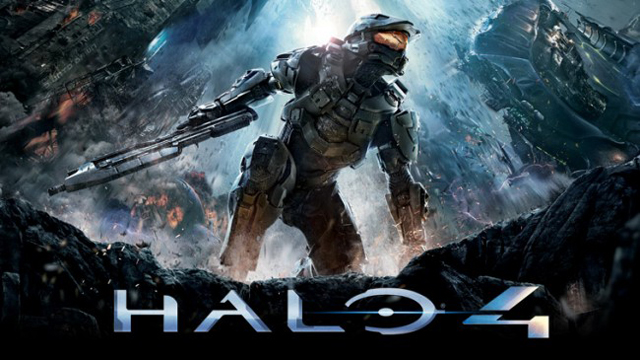
Despite it’s name, Halo 4 is actually the sixth installment in the Halo franchise (not counting Halo Wars). It’s arguably the most anticipated Halo game to date for a few reasons: first, it marks the return of Master Chief, who has been missing in action since Halo 3, which, despite its name, was three installments ago; second, it marks the dawn of a new trilogy in the series, the Reclaimer Saga; and third, Halo 4 is the first Halo game that’s not made by Bungie (again, not counting Halo Wars). When Microsoft and Bungie split in 2007, Microsoft handed the keys to its proverbial Ferrari over to newly created 343 Industries. Five years later, the development studio is finally ready to take the publisher’s prized possession out for a spin.
Halo 4 picks up four years and seven months after the events in Halo 3. Master Chief is awakened from cryo sleep by Cortana to find that their ship, the UNSC Forward Unto Dawn, is being torn to shreds, invaded by Covenant forces (“I thought we had a truce” he quips), and pulled toward a Forerunner planet known as Requiem. There’s not an awful lot more I can tell you about the story (Microsoft has rightly requested we not spoil any major plot points/twists), except to say that once again Master Chief is called upon to save humanity, only this time it’s a more personal story with the humanization of Master Chief, and a more emotional journey with the fate of his AI pal, Cortana, resting in the balance as she nears the end of her life cycle.
‘Familiar’ is the word I would use to describe the campaign. Five minutes into the story and already you’re fighting a familiar foe, the Covenant, in an opening scene that is eerily reminiscent of the opening mission in the original Halo. That sense of déjà vu spans the entire campaign, right down to the final chapter, and a lot of that has to do with level and mission design, which is a little too similar to previous Halo entries. It’s almost as if Bungie supplied 343 Industries with step-by-step instructions on how to construct the campaign, and 343 Industries followed them to a T.
It’s not long after you land on Requiem that you’re introduced to a new enemy race: the Prometheans. Consisting of a handful of enemy types, the Prometheans present an interesting challenge in combat, particularly the Watchers. A sentry-like adversary, Watchers provide various tactical advantages to their allies on the battlefield, emitting beams that shield Knights and Crawlers, snatching grenades you’ve throw in their direction and tossing them back at you, and even resurrecting fallen comrades before their “souls” vanish. In other words, destroy the Watchers first. The Prometheans sport an arsenal of hard light-based weapons. When you pick up one of these weapons for the first time, they assemble in your hands, but unfortunately that’s the only creative thing about them. It’s a surprisingly uninspired bunch of weapons that form your usual archetypes: handgun, shotgun, submachine gun, assault rifle, sniper rifle, rocket launcher, etc. The Covenant arsenal at least featured unique weapons such as the Needler and the Energy Sword.
There are a couple of new UNSC weapons and vehicles in the game, along with a handful of new features, for better or worse. Four years of stasis has apparently cost Master Chief his ambidexterity, as he can no longer dual-wield, but he can sprint now and his limited number of melee attacks have been expanded considerably (including some very cool stealth kill animations). Similar to the system in Halo: Reach, Master Chief also has access to various armor abilities, including Promethean Vision, which allows him to see enemies through hard surfaces; Hologram, which projects a holographic decoy to distract enemies; and Active Camouflage, which renders him nearly invisible to enemies, just to name a few.
In the end, I feel 343 Industries played it a little too safe with the campaign. I’m intrigued by the direction of the story – which features a genuinely touching moment – but I was hoping to be taken to unexpected places, to be shown unexpected things, and for the most part that didn’t happen. The epilogue hints at more of the same, but perhaps now that they have this experience under their belt, 343 Industries will feel a little more comfortable, a little more confident, and take a few more chances with the campaign in Halo 5.
Multiplayer in Halo 4 consists of two major components: Spartan Ops and War Games. Rather than include Firefight, the trendy, enemy-in-waves based co-operative mode first seen in Halo: ODST, 343 Industries chose instead to create Spartan Ops, a co-op campaign that follows up on the events of the main story. Playable with up to four players, 343 Industries plans to release Spartan Ops episodes free of charge over the course of the next few months. The first episode, consisting of five chapters, is available at launch and follows a team of Spartans from the UNSC Infinity as they embark on a mission to the Forerunner world of Requiem. An intro video provides backstory for the episode, but I wish the chapters flowed a little better. Each combat-heavy chapter lasts roughly ten minutes, but there’s no real connection from one chapter to the next. It just seems like a series of random missions using recycled environments from the main campaign. I see great potential in Spartan Ops, I just hope future episodes show a little more polish.
War Games is Halo 4’s competitive multiplayer component, initially consisting of 11 game types across 10 maps. The usual suspects, including Slayer, Team Slayer, King of the Hill, Oddball and Flood are all present, along with two new entries: Extraction and Regicide. Regicide is similar to Slayer or Team Slayer, except in Regicide one player is marked as the king, offering double or triple score for killing that one Spartan. Extraction is like a combination of Dominion and Capture the Flag, with Spartan teams attempting to extract assets from various sites while defending their beacons to prevent the opposing team from converting the extraction process in their own favor. Unlike Halo: Reach, none of the maps are recycled from campaign levels; they’ve all been built from the ground up.
The UNSC Infinity is the hub of the multiplayer experience. Here, you’ll build a custom Spartan-IV super soldier and progress your career across all competitive and co-operative game modes. In an attempt to marry multiplayer to the in-game fiction, War Games is a simulated training grounds for Spartans in preparation for Spartan Ops missions. Whether Halo veterans catch on to that or even care, I don’t know, but what it means is you’ll be able to level up your Spartan-IV in all sorts of ways. Weekly and monthly challenges across all game types – Campaign, Spartan Ops and War Games – means players can earn experience points even if they’re not a fan of Halo’s competitive multiplayer.
As you gain experience points, your Spartan-IV will level up and earn Spartan Points that can be used to unlock new weapons, armor abilities, etc. (though most unlocks require you to attain a certain level before they can be purchased). An expanded loadout system allows players to pre-select a primary and secondary weapon, a grenade type, an armor ability, tactical package and support upgrade. Tactical packages include such things as “mobility”, which allows unlimited sprint, or “grenadier”, which increases your grenade carrying capacity. Preparing these loadouts allows players to switch from one style of play to another mid-match.
343 Industries has clearly taken a few multiplayer cues from Call of Duty. During competitive matches, XP gained immediately pops up in the center of the screen. When you achieve enough kills to fill an on-screen meter, you’ll earn the opportunity to call in ordnance. Don’t worry, Halo fans, these don’t consist of air strikes or nukes, but rather rare weapon drops like a Sticky Detonator or a Gravity Hammer, or you might have the chance to gain special abilities like temporary speed or damage boosts.
Between the Spartan Ops episodes, War Games competitive suite, the returning Forge and Theater, and all of the upcoming DLC, the Halo 4 multiplayer experience is the highlight of the package and is sure to have players coming back for months, if not years to come.
From a visual standpoint, Halo has never looked so good. Everything from lighting to animations, physics to AI, is outstanding. The cinematics are without a doubt the best the Halo franchise has seen thus far. The only bad thing I can say about the visuals is that the lip-synching could use some work. On the audio side of things, I don’t know if it’s just me but the weapon effects sound deeper and more impacting, and the Covenant sound more menacing than ever before. Primarily mechanical in nature, the Promethean constructs sound appropriately metallic. The soundtrack is fantastic. It might not be as memorable as the Monk chants in the original Halo, but composer Neil Davidge has done a wonderful job giving Halo 4 a distinct, sweeping score.
343 Industries had some very big Spartan boots to fill when took over the reigns of the Halo franchise from Bungie. All things considered they’ve done a tremendous job. Where they come up a little short is the campaign, which feels all too familiar gameplay wise to previous Halo installments. They played it safe and it shows. Hopefully 343 Industries has gained the confidence to take a few more creative risks as the Reclaimer saga unfolds. That being said, multiplayer continues to shine. Between Spartan Ops and War Games, co-op and competitive gamers alike have more than enough reason to book their first-class ticket to the UNSC Infinity.
Reviewed By: Stephen Riach
Publisher: Microsoft Studios
Rating: 90%
——————————————————————————–
This review is based on copy of Halo 4 for the Xbox 360 provided by Microsoft Studios.
 Game Over Online
Game Over Online